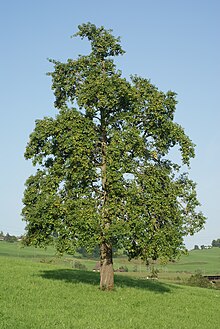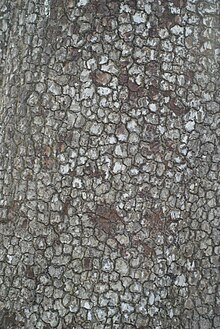Yellow Möstler
The Gelbmöstler (also Möstler , Gälmöstler or Drip Pear ) is a variety of the pear ( Pyrus communis ).
Synonyms
Synonyms for the Gelbmöstler are Möstler, Gelbmöstler, Gelbmostler ( Austria ), Gälmöstler ( Switzerland ), Möstler, Tropfbirne, Welsche Bergbirne (German shore of Lake Constance and Vorarlberg ), Helleger Mostbirne (Vorarlberg).
Origin and Distribution
The variety presumably comes from Bernhardzell , Canton St. Gallen (Switzerland). From 1800 it was more widespread, initially mainly in northern Switzerland, later also in the Lake Constance region and the rest of Switzerland . Around 1870 it was widespread in the Swiss cantons of St. Gallen , Appenzell and Thurgau . The variety was introduced in Austria in 1885.
tree
The tree is very vigorous and healthy. The branches are slender and straight and densely covered with fruit wood. The summer shoots are light brown with many white spots. The eyes are very prominent. The leaf is medium-sized, ovate-round, almost dark green, slightly sawed or with entire margins. The bark is made up of many small squares with rounded corners. This pattern can often be used to quickly determine whether it is a tree of the Gelbmöstler variety.
Almost all trees show the right-handed twist that is characteristic of the Gelbmöstler variety .
fruit
The fruit is small to medium-sized, flat, spherical, medium-bellied, 40–55 mm high, 45–60 mm wide and rounded towards the calyx. The basic color is green-yellow to golden-yellow. The body color is usually missing. It is seldom washed out slightly reddish brown. The skin is smooth and slightly waxy. The stem is long, slightly curved and slightly fleshy at the root. There is a more or less pronounced russeting around the stem. The cup is usually even more rusty. The flesh is yellowish-white and coarse-grained. Usually only a few weakly developed nuclei are present.
use
The pear is used exclusively to make must. It gives a lot of clear must . However, this is a bit tart, which is why it is recommended to mix it with the juice of a sweeter variety.
Harvest time and storage
The maturation takes place in mid-September to October. The fruits are gradually ripe and fall from the tree prematurely (so-called drip variety). This is where the name "Tropfler" comes from. The fruits must be fully ripe and stored for a few days before they are musted. They become doughy very quickly.
Diseases
The variety is very prone to fire blight . Due to the fire blight, the variety is disappearing at a rapid pace and has almost completely disappeared from its original region of origin in Eastern Switzerland. The fire blight years of 2000, 2007, 2008 and 2011 in particular led to a sharp decline in the population. Today it is recommended that the variety no longer be planted as it promotes the spread of the fire blight.
Individual evidence
- ↑ Szalatnay, Kellerhals, Frei, Müller: Fruits, Berries, Nuts. 2001, p. 452.
- ↑ a b Josef Löschnig : The cider pears. Description of the most commonly planted cider pear varieties in Austria. 1913, p. 108.
- ↑ Swiss Fruit and Winegrowing Association (ed.): Description of Swiss fruit varieties. Issue 1. 1870, pp. 133-134.
- ↑ Fire blight, susceptibility of pome fruit varieties Version 8/2011 . Agroscope website. Retrieved January 21, 2013.
- ↑ Ban on planting fire blight plants in protected objects - Canton of Lucerne (Switzerland) . Website of the Agriculture and Forests Office of the Canton of Lucerne (Switzerland). Retrieved January 21, 2013.
literature
- Schweizerischer Obst- und Weinbauverein (Ed.): Description of Swiss fruit varieties. Issue 1. Edited by the fruit description commission. Printed and published by J. Huber, Frauenfeld 1870.
- Josef Löschnig: The cider pears. Description of the most commonly planted cider pear varieties in Austria. Published by the Austrian Fruit Growing and Pomologists Society with the support of the KK Agriculture Ministry. Edited with the participation of members of the company by the manager Josef Löschnig. F. Sperl, Vienna 1913.
- David Szalatnay, Markus Kellerhals, Martin Frei, Urs Müller: Fruits, berries, nuts. The variety of varieties - 800 portraits. Haupt, Bern et al. 2011, ISBN 978-3-258-07194-7 .


